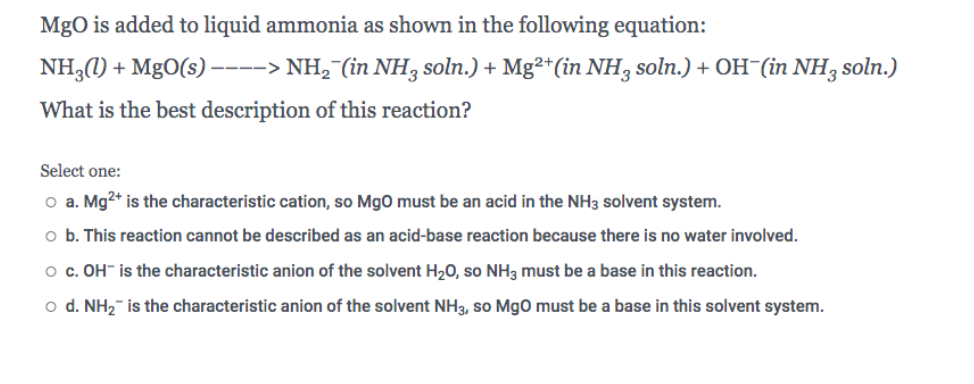MgO is added to liquid ammonia as shown in the following equation: NH;() + MgO(s) –---> NH,¯(in NH, soln.) + Mg²*(in NH, soln.) + OH¯(in NH, soln.) What is the best description of this reaction? Select one: o a. Mg?* is the characteristic cation, so MgO must be an acid in the NH3 solvent system. o b. This reaction cannot be described as an acid-base reaction because there is no water involved. o c. OH" is the characteristic anion of the solvent H20, so NH3 must be a base in this reaction. o d. NH2 is the characteristic anion of the solvent NH3, so Mg0 must be a base in this solvent system.
MgO is added to liquid ammonia as shown in the following equation: NH;() + MgO(s) –---> NH,¯(in NH, soln.) + Mg²*(in NH, soln.) + OH¯(in NH, soln.) What is the best description of this reaction? Select one: o a. Mg?* is the characteristic cation, so MgO must be an acid in the NH3 solvent system. o b. This reaction cannot be described as an acid-base reaction because there is no water involved. o c. OH" is the characteristic anion of the solvent H20, so NH3 must be a base in this reaction. o d. NH2 is the characteristic anion of the solvent NH3, so Mg0 must be a base in this solvent system.
Introductory Chemistry: A Foundation
9th Edition
ISBN:9781337399425
Author:Steven S. Zumdahl, Donald J. DeCoste
Publisher:Steven S. Zumdahl, Donald J. DeCoste
Chapter7: Reactions In Aqueous Solutions
Section: Chapter Questions
Problem 74AP
Related questions
Question
Please explain answer

Transcribed Image Text:MgO is added to liquid ammonia as shown in the following equation:
NH3(1) + MgO(s)----> NH,¯(in NH3 soln.) + Mg²*(in NH3 soln.) + OH (in NH3 soln.)
What is the best description of this reaction?
Select one:
o a. Mg2* is the characteristic cation, so MgO must be an acid in the NH3 solvent system.
o b. This reaction cannot be described as an acid-base reaction because there is no water involved.
o c. OH" is the characteristic anion of the solvent H20, so NH3 must be a base in this reaction.
o d. NH2- is the characteristic anion of the solvent NH3, so MgO must be a base in this solvent system.
Expert Solution
This question has been solved!
Explore an expertly crafted, step-by-step solution for a thorough understanding of key concepts.
This is a popular solution!
Trending now
This is a popular solution!
Step by step
Solved in 2 steps

Knowledge Booster
Learn more about
Need a deep-dive on the concept behind this application? Look no further. Learn more about this topic, chemistry and related others by exploring similar questions and additional content below.Recommended textbooks for you

Introductory Chemistry: A Foundation
Chemistry
ISBN:
9781337399425
Author:
Steven S. Zumdahl, Donald J. DeCoste
Publisher:
Cengage Learning

Chemistry: Principles and Practice
Chemistry
ISBN:
9780534420123
Author:
Daniel L. Reger, Scott R. Goode, David W. Ball, Edward Mercer
Publisher:
Cengage Learning

General Chemistry - Standalone book (MindTap Cour…
Chemistry
ISBN:
9781305580343
Author:
Steven D. Gammon, Ebbing, Darrell Ebbing, Steven D., Darrell; Gammon, Darrell Ebbing; Steven D. Gammon, Darrell D.; Gammon, Ebbing; Steven D. Gammon; Darrell
Publisher:
Cengage Learning

Introductory Chemistry: A Foundation
Chemistry
ISBN:
9781337399425
Author:
Steven S. Zumdahl, Donald J. DeCoste
Publisher:
Cengage Learning

Chemistry: Principles and Practice
Chemistry
ISBN:
9780534420123
Author:
Daniel L. Reger, Scott R. Goode, David W. Ball, Edward Mercer
Publisher:
Cengage Learning

General Chemistry - Standalone book (MindTap Cour…
Chemistry
ISBN:
9781305580343
Author:
Steven D. Gammon, Ebbing, Darrell Ebbing, Steven D., Darrell; Gammon, Darrell Ebbing; Steven D. Gammon, Darrell D.; Gammon, Ebbing; Steven D. Gammon; Darrell
Publisher:
Cengage Learning

Chemistry: The Molecular Science
Chemistry
ISBN:
9781285199047
Author:
John W. Moore, Conrad L. Stanitski
Publisher:
Cengage Learning

Chemistry & Chemical Reactivity
Chemistry
ISBN:
9781133949640
Author:
John C. Kotz, Paul M. Treichel, John Townsend, David Treichel
Publisher:
Cengage Learning

Chemistry & Chemical Reactivity
Chemistry
ISBN:
9781337399074
Author:
John C. Kotz, Paul M. Treichel, John Townsend, David Treichel
Publisher:
Cengage Learning